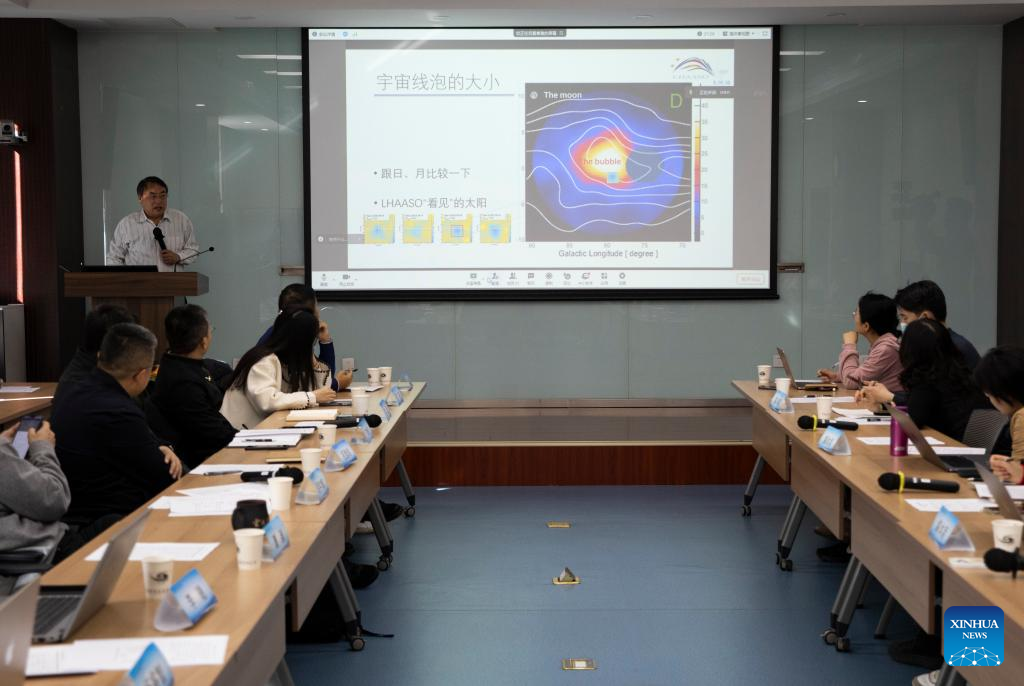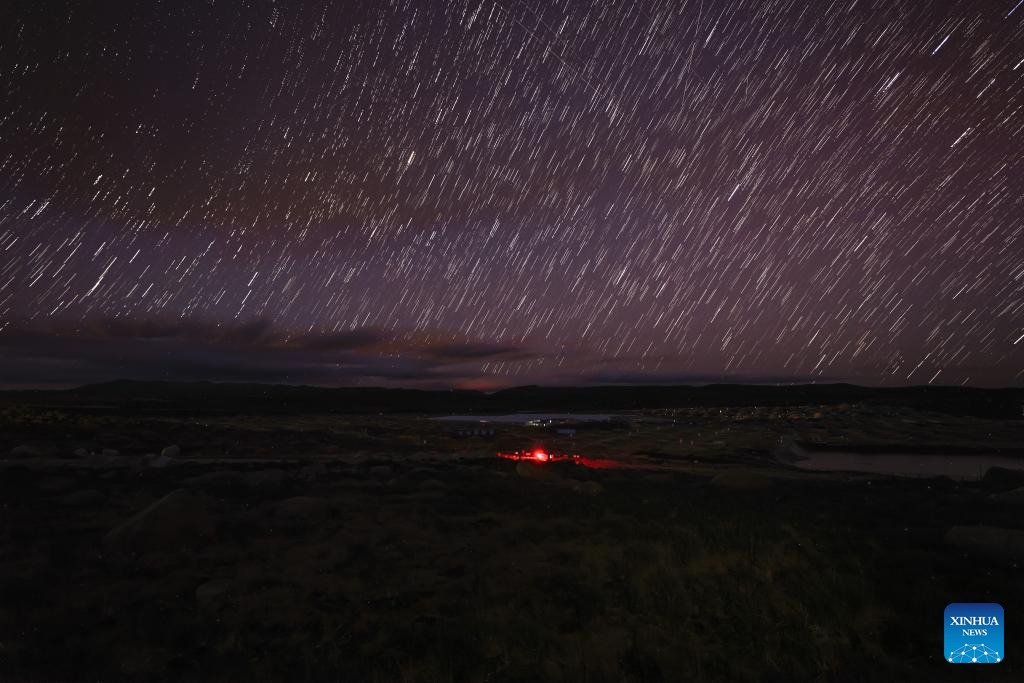27.02.2024

Cao Zhen, principal investigator of Large High Altitude Air Shower Observatory (LHAASO) and an academician of Chinese Academy of Sciences (CAS), introduces research findings at the Institute of High Energy Physics of CAS, in Beijing, capital of China, Feb. 22, 2024. China's cosmic ray observatory has discovered a giant ultra-high-energy gamma-ray bubble structure, about ten million times larger than our solar system, in the Cygnus star-forming region, around 5,000 light years from Earth.(Xinhua/Jin Liwang)
China's cosmic ray observatory has discovered a giant ultra-high-energy gamma-ray bubble structure, about ten million times larger than our solar system, in the Cygnus star-forming region, around 5,000 light years from Earth.
Based on the observations made by China's Large High Altitude Air Shower Observatory (LHAASO), scientists identified that star-forming region as one source of the cosmic rays in the Milky Way with an energy level higher than 10 peta-electron volts (quadrillion electron volts or PeV), about 1,000 times more than the record high achieved by any manmade accelerator on Earth.
"This is the first super cosmic ray accelerator identified as of now. With increasing observation time, LHAASO is expected to detect more super cosmic ray accelerators, and hopefully solve the mystery behind the origins of cosmic rays in the Milky Way," said Cao Zhen, principal investigator of LHAASO and an academician of Chinese Academy of Sciences (CAS).
The discovery was published in the academic journal Science Bulletin on Monday.
Cosmic rays are charged particles from outer space, mainly composed of protons. The origin of cosmic rays is one of the most important frontier issues in modern astrophysics.
Measurements of cosmic rays in past decades have revealed a break around 1 PeV in the energy spectrum, which is called the "knee" of the cosmic ray energy spectrum due to its shape resembling a knee joint. However, the origin of cosmic rays in the "knee" region is still an unsolved mystery and one of the most intriguing topics in cosmic ray research in recent years, said Cao.
LHAASO has discovered a giant ultra-high-energy gamma-ray bubble structure in the Cygnus star-forming region, with multiple photons exceeding 1 PeV inside the structure, with the highest energy reaching 2.5 PeV, said Yang Ruizhi, a key member of the research team.
That discovery indicates the presence of a super cosmic ray accelerator inside the bubble, which continuously accelerates high-energy cosmic ray particles with energies of up to 20 PeV and injects them into interstellar space. These high-energy cosmic rays collide with interstellar gas and produce gamma rays, Yang said.
The massive star cluster, Cygnus OB2, composed of many young, hot, massive stars, near the center of the bubble is the most promising candidate for the super cosmic ray accelerator, Yang said.
The radiation luminosity of these stars is hundreds to millions of times that of the Sun, and the huge radiation pressure blows away the surface material of the stars, forming dynamic stellar winds with speeds up to thousands of kilometers per second. The collision of stellar winds with the surrounding interstellar medium and the violent collision between stellar winds have created ideal sites for efficient particle acceleration, he explained.
"We are looking forward to finding more similar cosmic ray sources through more observation to truly understand the mechanisms that can accelerate cosmic ray particles to such high energy, and to solve the century-long enigma of the origin of cosmic rays," said Cao.
LHAASO, located at an altitude of 4,410 meters on Mount Haizi in Daocheng County, southwest China's Sichuan Province, is China's national key scientific and technological infrastructure focusing on cosmic ray research.
The observatory, which is the most sensitive ultra-high-energy gamma-ray detection device in the world, was completed in July 2021 and began high-quality and stable operation after that. The facility is operated by the Institute of High Energy Physics of CAS with a universal international cooperation model to achieve open sharing of facility platforms and observational data. Currently, 32 domestic and foreign astrophysics research institutions have become international collaboration members of LHAASO. ■

Cao Zhen (1st R, front), principal investigator of Large High Altitude Air Shower Observatory (LHAASO) and an academician of Chinese Academy of Sciences (CAS), answers questions at the Institute of High Energy Physics of CAS, in Beijing, capital of China, Feb. 22, 2024. China's cosmic ray observatory has discovered a giant ultra-high-energy gamma-ray bubble structure, about ten million times larger than our solar system, in the Cygnus star-forming region, around 5,000 light years from Earth.(Xinhua/Jin Liwang)

Cao Zhen (at the podium), principal investigator of Large High Altitude Air Shower Observatory (LHAASO) and an academician of Chinese Academy of Sciences (CAS), introduces research findings at the Institute of High Energy Physics of CAS, in Beijing, capital of China, Feb. 22, 2024. China's cosmic ray observatory has discovered a giant ultra-high-energy gamma-ray bubble structure, about ten million times larger than our solar system, in the Cygnus star-forming region, around 5,000 light years from Earth.(Xinhua/Jin Liwang)

This composite photo taken on April 21, 2023 shows the Large High Altitude Air Shower Observatory (LHAASO) at an altitude of 4,410 meters on Mount Haizi in Daocheng County, southwest China's Sichuan Province. China's cosmic ray observatory has discovered a giant ultra-high-energy gamma-ray bubble structure, about ten million times larger than our solar system, in the Cygnus star-forming region, around 5,000 light years from Earth.(Xinhua/Jin Liwang)
Quelle: Xinhua
